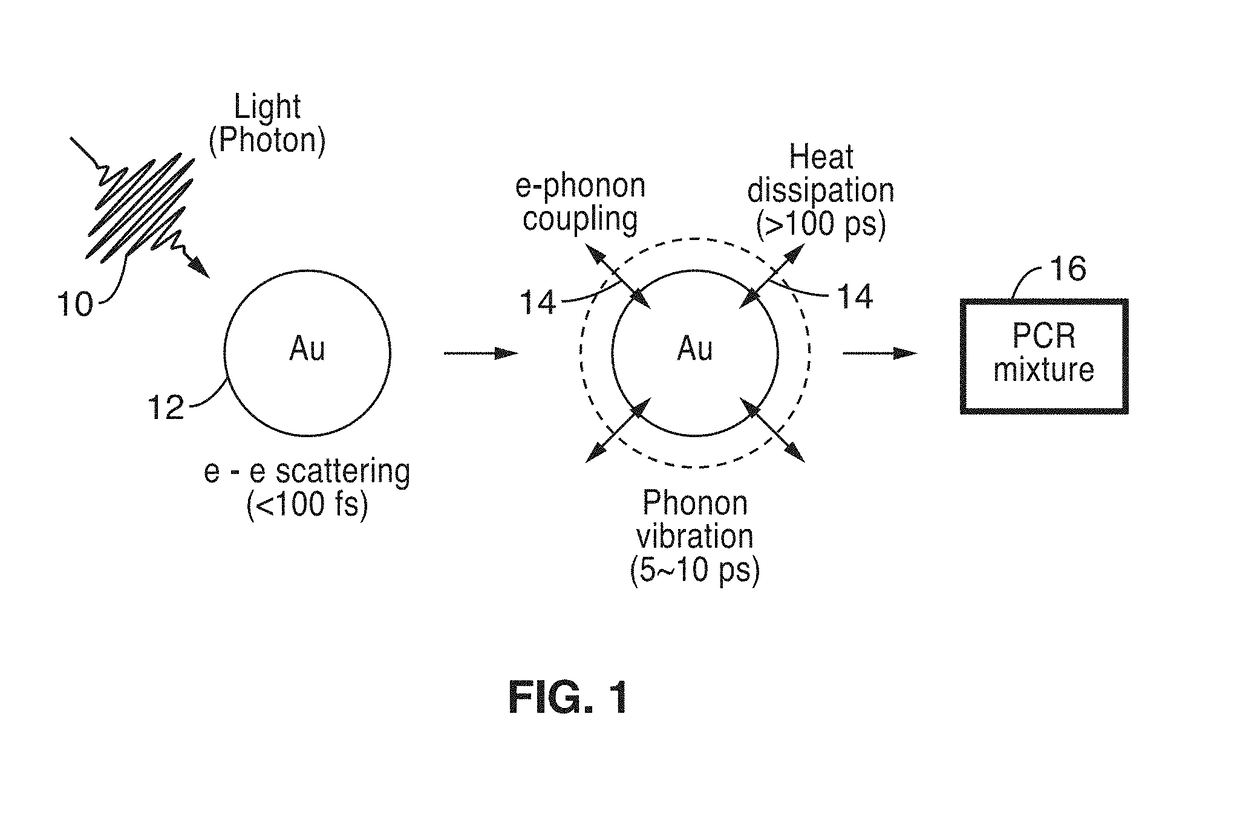LED driven plasmonic heating apparatus for nucleic acids amplification
a plasmonic heating and nucleic acid technology, applied in biochemistry apparatus and processes, laboratories glassware, etc., can solve the problems of high cost of lasers and detection systems, inability to perform poc testing, and inability to meet the needs of poc testing, etc., to achieve low power consumption, low power consumption, and easy use
- Summary
- Abstract
- Description
- Claims
- Application Information
AI Technical Summary
Benefits of technology
Problems solved by technology
Method used
Image
Examples
example 1
[0057]a. Fabrication
[0058]Several 4 mm-thick poly(methyl methacrylate) (PMMA) sheets 26 were cut with a VersaLASER VL-200 laser cutting system (Universal Laser System, Inc.) to make reaction wells 24 with a 4 mm diameter. A 1.5 mm-thick bottom PMMA sheet were attached to the top sheet containing reaction wells were bonded together using the thermal bonding. Thermal bonding was performed at 84° C. with pressure of 1.0 metric ton after UV / Ozone treatment of PMMA sheet for 10 min. The thin Au films 20 of different thicknesses were deposited by electron beam evaporation under base pressure of 2×10−7 Torr. The thin Au film 20 was then passivated with thin poly(dimethylsiloxane) (PDMS) by dropping 3 μL of PDMS into the well and curing in the oven for 2 hrs to prevent PCR reaction inhibition by the thin Au film and thermocouple.
[0059]b. Simulation
[0060]COMSOL Multiphysics software (Ver. 4.3) was used for performing simulations. The detailed geometry and materials properties for simulation ...
example 2
[0083]FIG. 11 shows the schematics of experimental set up 50 for LED driven plasmonic heating of thin Au films. Blue LEDs 22 with 447.5 nm peak wavelength were used for light illumination and the light from LEDs was focused by commercially available plastic lens 32. The thin Au films 20 with nanometer sized grain were deposited by an electron beam evaporation method. The surface temperature of liquid 16 was measured by long wavelength infrared (LWIR) camera 52.
[0084]FIG. 12 shows the demonstration of fast thermal cycle using 2 μL of glycerol from 50° C. to 90° C. for 9 min using LED driven plasmonic heating of thin Au films. The injection current was 1 A, and the thickness of thin Au film was 56 nm.
[0085]FIG. 13A shows the temperature changes of liquid with different thin Au films thickness. As the thickness of Au film increase, the maximum temperature of liquid is increased, as shown in FIG. 13B. The temperature of liquid was rapidly decreased after turn off of LEDs.
[0086]FIG. 13C ...
PUM
| Property | Measurement | Unit |
|---|---|---|
| temperature | aaaaa | aaaaa |
| temperature | aaaaa | aaaaa |
| power consumption | aaaaa | aaaaa |
Abstract
Description
Claims
Application Information
 Login to View More
Login to View More - R&D
- Intellectual Property
- Life Sciences
- Materials
- Tech Scout
- Unparalleled Data Quality
- Higher Quality Content
- 60% Fewer Hallucinations
Browse by: Latest US Patents, China's latest patents, Technical Efficacy Thesaurus, Application Domain, Technology Topic, Popular Technical Reports.
© 2025 PatSnap. All rights reserved.Legal|Privacy policy|Modern Slavery Act Transparency Statement|Sitemap|About US| Contact US: help@patsnap.com



